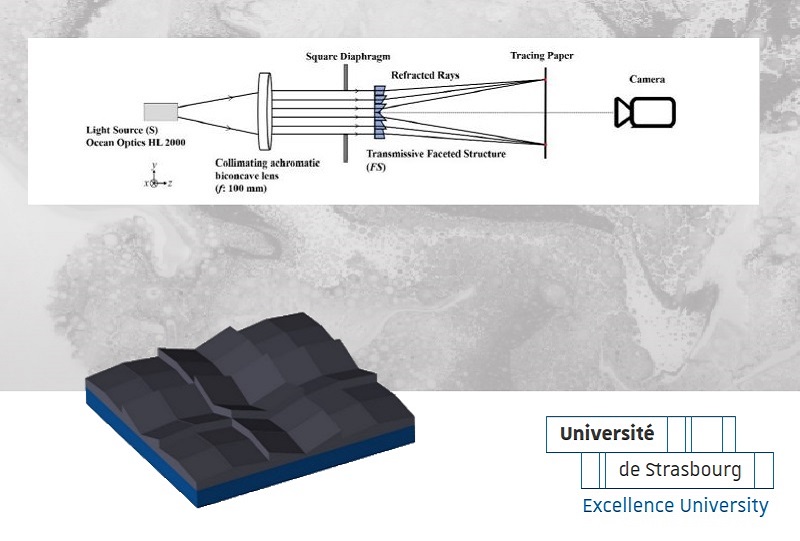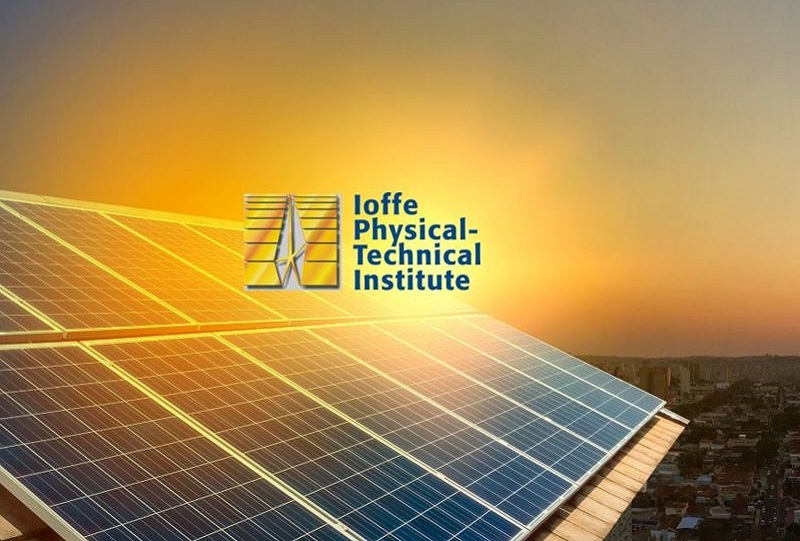Project Description
White Light Beam Shaping: New Optical Component for Reshaping a Collimated Light Beam by Faceted Elements
A new optical component with a faceted element which allows the reshaping of a collimated white light beam is depicted and realized. The structure is made of several facets with different tilt angles. After being illuminated, the faceted structure with specific 2D angular distributions redirects the beam onto the target plan with the desired irradiance map. Upon the established knowledge of the optical configuration, the analytical solution for the faceted structure in the transmissive module is presented. Also, 3D printed optical components were fabricated using innovative additive optics fabrication technology by Luximprint. This case study is an excerpt of the final research that appeared as a contributed article in the September issue of OSA Continuum.
Introduction
The shaping of a white light beam with high quality is important in non-imaging optics. Various kinds of optical elements have been proposed to reshape light with large spectrum. Diffractive Optical Element (DOE) is mainly designed to reshape monochromatic and spatially coherent light, but only few results have been reported for non-laser source. For example, a lightpipe is used for example in the microdisplay and is focused on the efficiency and uniformity of the light on the output plan. In the areas of solar energy, non-imaging Fresnel lenses have been designed as the concentrators.
Freeform optics for beam shaping involves a series of calculation and optimization methods. But the fabrication of the surface profile of the free-form is still very complicated and expensive. For lighting and illumination, some other solutions are also possible in the field of faceted structures. But the overall geometrical structure is rotationally symmetric, and arbitrary irradiance distribution has not been reported yet. In another domain, Weyrich et al. create the idea of “microfacet height field” by series of algorithms to obtain a custom reflectance. In the same way, independently, we see some faceted structures called mirror cells arrays fabricated by two-photon polymerizations in the recent literature.
Geometrical Optics For White Light Beam Shaping
We propose another approach based on geometrical optics to allow white light beam shaping. Our optical element is studied to achieve arbitrary intensity distribution, and the geometrical dimensions of the facets are large with respect to the wavelength.
Our optical configuration contains a white light source, the faceted structure and the detector. The optical element is composed of a matrix of facets distributed in two directions, each facet being a square whose size is larger than 1mm. To reshape light, an original automatic optimization method was proposed in a previous work employing the non-sequential mode of Zemax OpticStudio. The front face of each facet has two orientations which are the variables being adjusted in the optimization process. However, the time of the optimization was very long.
Although different custom irradiance distributions have been achieved based on the optimization process, a complete analytical approach is also established here to confirm our theory of a faceted structure and allows the improving of the result. In this article, the analytical relationship between the 2D angular distributions of the faceted structure and the local coordinate of the beam on the detector is calculated.
Based upon the established equations, when the desired irradiance map is given, the angular distributions can be computed directly. Then, using a house-made Monte Carlo raytracing program, the irradiance map can be calculated directly in Matlab. Afterward, the calculated faceted model is transferred to the optical illumination software of Zemax OpticStudio or LightTools from Synopsis, which can directly confirm the light redistribution result on the target plan with the fixed distance. The simulation result in illumination software will be numerically compared with the analytical result using the efficiency or the homogeneity.
Finally, the realization of the component with innovative additive optics fabrication technology of Luximprint was proposed and demonstrated.
The Approach: Optical Configuration
The optical configuration is the simply composed of a source of visible light (S), the faceted surface (F) and the detector (D), visible in Figure 2 below.

Figure 2: General 2D view of the optical configuration with illumination source (S), transmissive faceted structure (FS), and the detector (D).
In our design, the incident beam is collimated and uniform, and the faceted surface employs a matrix of NFx × NFy facets. To avoid the influence of imperfect surface, our theoretical reflective model is based on the hypothesis of perfect specular reflection, and so, the material of the faceted surface is defined to be a perfect mirror in the following analytical expressions. For the transmissive faceted surface, the refractive index for each wavelength depends on the property of the material, which will be explained in detail in the following sections.
The Results: Optics Design
The local illumination result in Matlab and the global illumination result in Zemax and LightTools are presented in this section. The desired illumination pattern is a four-symmetric spaced squares on a plane.
FS is made of 6 × 6 facets: the size of the facet element (px × py) is here 5 mm × 5 mm, to be large in comparison with the wavelength. The distance (dFD) between the rear base plan of the faceted structure and the detector is 50 mm. The material (refractive index and transmission coefficient) of the faceted structure was defined according to the provided information from Luximprint, whose transparent 3D printing technology is adopted to realize the fabrication. The refractive index was used at the wavelength of 604 nm which corresponds to the primary wavelength of the source (Ocean Optics HL 2000) employed in our experiment. The raytracing configuration in Zemax and the 3D scheme of FS are shown in Figure 3 below.

Figure 3: The raytracing configuration in OpticStudio 16 and the 3D scheme of the faceted structure.
For different design examples, the self-shadowing and the edges of the facets may cause severe artefacts only when the angles of the facets are large compared to the working distance. In our case, whatever the desired image, the interval of the possible angles is controlled to the minimum in the design process: this means that the self-shadowing effect is restricted to be as small as possible. Moreover, for the presented design in Fig. 4, both the chosen interval of the angles which is [-15°, 15°] and the facet element dimensions are a compromise between the shadowing effects and the fabrication specifications coming from additive manufacturing Luximprint.

Figure 4: Illumination pattern S4. (a) Local illumination result in Matlab. (b) Global illumination result in Zemax. (c) Global illumination result in LightTools.
Additive Optics Fabrication and Experiments
The fabrication of the transmissive faceted structure employed the transparent 3D printing technology from Luximprint. This optical 3D printing technology is inspired by the digital additive manufacturing process to fabricate typical array-typed component. Then, it is possible to use standard .step, .stl or .iges files to transfer the design information, which is under the requirements of the manufacturing process.
In Fig. 12, a square diaphragm manufactured by 3D Printing is put after the collimator to adjust the size of the beam. Benefits from the cooperation with Luximprint, a smooth surface profile fabrication technology was chosen. A tracing paper is put after the sample, which allows the image to be recorded by a digital camera. The main advantage of the tracing paper is the possibility to observe directly the irradiance map without parallax or distortion. The distance between the sample and the tracing paper dFD is 50 mm. The used camera is a DSLR Canon Camera 1000D with a standard EF-S zoom objective 18-55 mm. The experiment results before and after the tracing paper are given in Fig. 5

Figure 5: Experiment results. (a) Irradiance map was taken by the camera before the tracing paper. (b) Irradiance map after the tracing paper.
Conclusion
We demonstrate in this article the design and the fabrication of a transparent faceted structure to do beam shaping of a white light source. The optical concept is based on a matrix of small facets inclined in two directions. First, analytical expressions for the calculation of the angular positions and the raytracing method of the irradiance map on the target plan was explained in detail.
Moreover, the simulation results in Zemax OpticStudio 16 and LightTools 8.2 was compared with the analytical results and shows us the validity of our approach with a non-standard irradiance map. The fabrication was accomplished with an innovative additive optics fabrication technology proposed by Luximprint with an optically transparent material: the size of the facet are 5 mm and the component contain 6 x 6 facets.
The experimental irradiance map was recorded with a very simple optical setup and an estimation of the efficiency was also given using an image signal processing method to detect the target area. The demonstration of the optical concept of matrix of facets is here proposed in transmissive case, but the reflection case is also conceivable with our method : our analytical approach is able to taking account different parameters as the incident angle, the size of the facets, the angle of the irradiance map, etc…
Acknowledgements
The authors would like to acknowledge the financial support of Strasbourg University for the fabrication of the element, the cooperation program with INSA Strasbourg and the China Scholarship Council for the PhD Grant of Lihong Liu.
Sources: The Full Study, deployed by Lihong Liu and co-authored by Manuel Flury, INSA Strasbourg and Marco de Visser, Luximprint, appeared as an article in the first edition of the ‘OSA Continuum’. You can read the full article online, or download it as PDF.


















